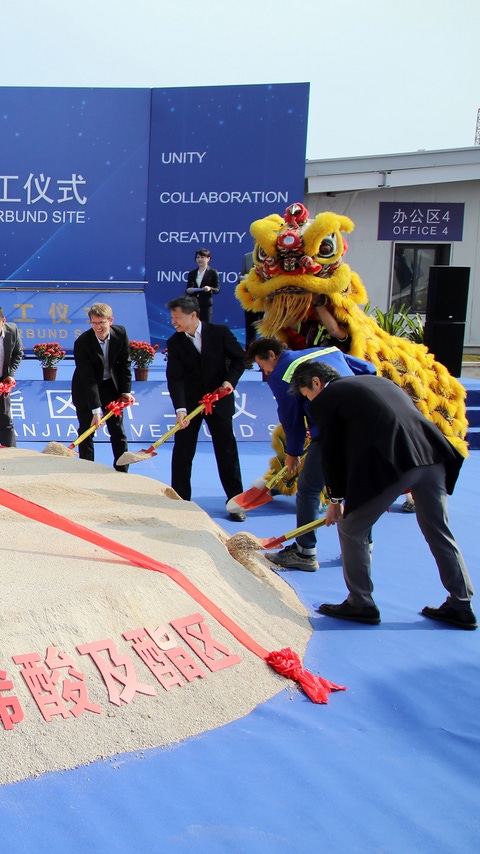巴斯夫大中华区2022年度报告
大中华区战略投资
- Continued to expand the Nanjing Verbund site in cooperation with Sinopec
- The Zhanjiang Verbund site project is well on schedule: the first plant inaugurated and the core of the Verbund under construction
- Expanded production capacity in Changsha and Ningxia for battery materials
- Formed a joint venture with Heraeus to provide precious metal recycling solutions in China
To support the growing demand from various industries in the Chinese market, BASF is strategically reinforcing its commitment to local production, not only at its Verbund sites in Nanjing and Zhanjiang but also at other sites across the country.
In April 2022, BYC BASF and Sinopec broke ground for the expansion of their Verbund site operated by BASF-YPC Co., Ltd. (BASF-YPC), a 50-50 joint venture of both companies in Nanjing. This expansion includes new production capacities of several downstream chemical plants for propionic acid, propionic aldehyde, ethylene amines, ethanol amines and purified ethylene oxide, and building a new tert-butyl acrylate plant. The new plant marks the first time that this advanced production technology is applied outside of Germany. The expanded and new plants are planned to come on stream by 2023.
In January, BASF-YPC successfully started the operation of its newly built Centralized Energy Recovery Unit for Off-gas Treatment (c-ERU), the company’s the first centralized off-gas treatment plant serving the whole Nanjing Verbund site. With its operation, off-gas streams from over 20 production plants at the Nanjing Verbund site, are centrally collected and treated, and transformed into useful energy by using the advanced technology, while NOx, volatile organic gas (VOC) and carbon emissions are reduced. The c-ERU can produce up to 270,000 tons of steam per year to be used in the production of the Nanjing Verbund site, reducing the annual natural gas consumption by 5.76 million cubic meters, and contributing to lowering the carbon footprint of the site.
The new Zhanjiang Verbund site, with investment of up to €10 billion by 2030, will be built in several phases and is expected to be fully operation by 2030. The project is now well on schedule. In September 2022, BASF inaugurated the first plant of its Zhanjiang Verbund site, producing 60,000 metric tons of engineering plastics compounds per year, and bringing BASF’s total capacity of engineering plastics in Asia Pacific to 420,000 metric tons from 2023. This new plant will enable BASF to meet the growing demand of its customers, particularly in the automotive and electronics industries. A plant for producing thermoplastic polyurethanes (TPU) will come on stream in 2023.
The next construction phase of the Zhanjiang Verbund site will focus on the core of the Verbund, including a steam cracker and several downstream plants for the production of petrochemicals and intermediates. For example, a new world-scale Neopentyl Glycol (NPG) plant with an annual production capacity of 80,000 metric tons will be built to strengthen BASF’s position as one of the world’s leading NPG manufacturers. The new NPG plant is expected to come on stream in 2025, by when BASF’s global NPG capacity will be boosted from 255,000 metric tons to 335,000 metric tons annually.
To meet the fast-growing local and global demands of the electric vehicle industry, BASF Shanshan Battery Materials Co., Ltd. (BSBM), a BASF majority-owned company in China (BASF 51%; Shanshan 49%), expanded its battery materials capacity in Changsha, Hunan province, and Shuizuishan, Ningxia province in 2022. The new lines in Changsha have gradually started commissioning already from the fourth quarter, enabling BSBM to achieve 100 kt annual capacity for cathode active materials.
The expansion project incorporates innovative energy recovery technologies including off-gas, waste heat and oxygen recycling, which are independently developed based on BSBM’s broad industrial operational experience and BASF’s chemical process design know-how.
China has limited natural resources in Platinum Group Metals (PGMs) consisting predominately of platinum, palladium and rhodium and strongly relies on imports. To recover PGMs from spent automotive catalytic converters and enable a circular economy, BASF and Heraeus have formed a 50:50 joint venture named BASF HERAEUS (China) Metal Resource Co., Ltd, in Pinghu, ground-breaking in November 2022 and planned to start operation in 2023. Recycled precious metals are also very environmentally friendly and have as much as a 90 percent lower CO2 footprint than primary metals from a mine.
